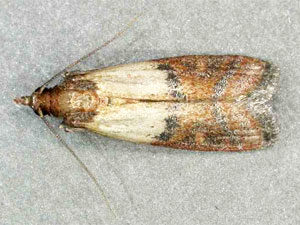If you see moths fluttering around your pantry, cupboards, shelves or other food storage areas, you could be under siege by Indian Meal Moths. These creatures are the most common stored-food pest in homes, food processing and manufacturing plants, as well as grocery stores.
Getting rid of these pantry pests can be a disheartening experience; it usually requires you to dispose of most, if not all, of the stored foods in the affected area.
How Do I Know If I Have an Indian Meal Moth Problem?
Unfortunately, they are hearty eaters. In their larval stage, Indian Meal Moths may be found feasting on a wide variety of foods, including:
- Stored bird seed (a favorite)
- Pet foods (also a favorite)
- Nuts (another favorite)
- Dried fruits and seeds
- Grains, including cereals
- Powdered milk
- Popcorn
- Spices
If you find a silky web stuck to any of these food surfaces or see maggot-looking larvae, it’s a good bet that you have an Indian Meal Moth problem. Another sure sign of an infestation is presence of small cocoons in places where walls meet the ceiling or other corners.


It’s fairly easy to identify Indian Meal Moths. They’re about ⅝ – ¾ inches long, and their forewings are distinctive, with the outer two-thirds a reddish brown or coppery color.
It’s tough to keep them out of your food supplies, since Indian Meal Moths can chew through plastic bags, cardboard, and aluminum foil. They’ll even slip inside a container when the lid isn’t screwed on tight. Even if you’ve never had a problem before, they can hitchhike into your home on a pet food bag or other food source that’s been contaminated with eggs or larvae.
From our experience, Indian Meal Moths tend to contaminate food that hasn’t been used in a long time. To discourage moths from sharing your meals, clean out your pantry at least once a year by using up or throwing away old items. Additionally, remove old grass and bird seed from the garage or avoid storing it altogether. Keep an eye on pet food containers and clean them out regularly.
When you have a problem with these pests, though, your best defense is to call a pest control expert.

As a Home Protection Plan customer, if you’re not satisfied with our pest control service, we will service your home at no additional cost until your issue is solved or receive your money back from your last scheduled service.

Our pest management professionals will help you:
- Identify and dispose of all food that has been contaminated
- Clean and treat the infested site and surrounding areas
- Locate and eliminate moths in larval and pupal stages
- Install insect pheromone traps to capture and disrupt the breeding cycle of the remaining moths.
We know how to properly remove these critters from your home do so in a safe way. As soon as you notice one of these creatures in your home, call our team to have them eliminated.
To schedule moth removal in Baltimore or a surrounding area, give us a call at (410) 653-2121 or contact us online!


